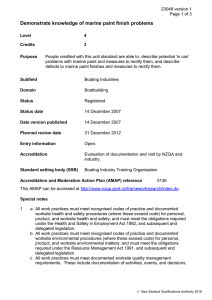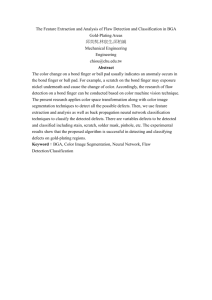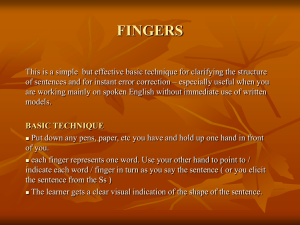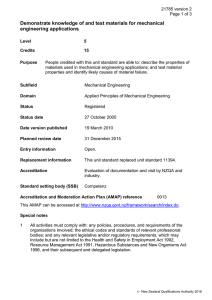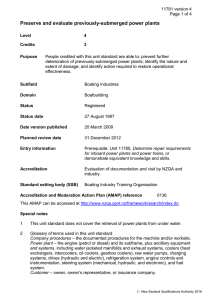Identify, diagnose and rectify finger jointed product defects
advertisement
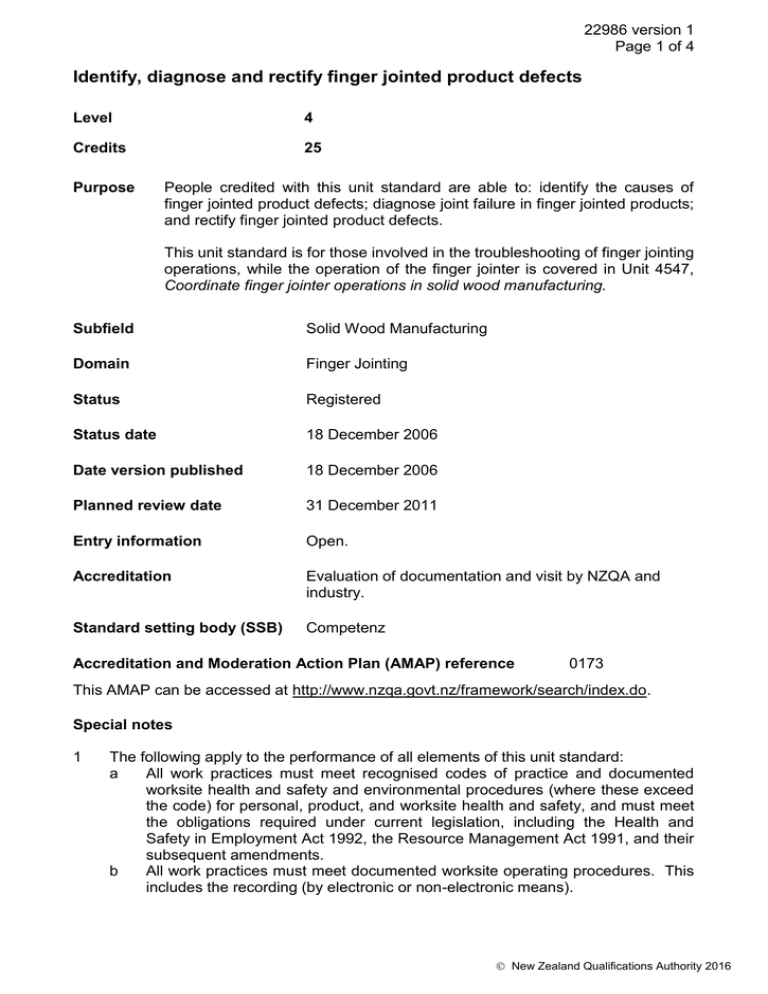
22986 version 1 Page 1 of 4 Identify, diagnose and rectify finger jointed product defects Level 4 Credits 25 Purpose People credited with this unit standard are able to: identify the causes of finger jointed product defects; diagnose joint failure in finger jointed products; and rectify finger jointed product defects. This unit standard is for those involved in the troubleshooting of finger jointing operations, while the operation of the finger jointer is covered in Unit 4547, Coordinate finger jointer operations in solid wood manufacturing. Subfield Solid Wood Manufacturing Domain Finger Jointing Status Registered Status date 18 December 2006 Date version published 18 December 2006 Planned review date 31 December 2011 Entry information Open. Accreditation Evaluation of documentation and visit by NZQA and industry. Standard setting body (SSB) Competenz Accreditation and Moderation Action Plan (AMAP) reference 0173 This AMAP can be accessed at http://www.nzqa.govt.nz/framework/search/index.do. Special notes 1 The following apply to the performance of all elements of this unit standard: a All work practices must meet recognised codes of practice and documented worksite health and safety and environmental procedures (where these exceed the code) for personal, product, and worksite health and safety, and must meet the obligations required under current legislation, including the Health and Safety in Employment Act 1992, the Resource Management Act 1991, and their subsequent amendments. b All work practices must meet documented worksite operating procedures. This includes the recording (by electronic or non-electronic means). New Zealand Qualifications Authority 2016 22986 version 1 Page 2 of 4 c 2 All evidence of communications gathered in relation to this unit standard must be in accordance with worksite procedures for content, recipient, timing, and method. Definition Worksite documentation refers to instructions to staff on policy and procedures (including the application of legislation to worksite situations) which are formally documented, and are available for reference at the worksite. Examples are standard operating procedures, specifications, manuals, and manufacturer's information. Elements and performance criteria Element 1 Identify the causes of finger jointed product defects. Performance criteria 1.1 Raw material characteristics influencing final product quality are identified from product samples. Range 1.2 Machine operating faults that influence final product quality are identified from supplied samples. Range 1.3 alignment, spread. Machine factors that affect final product quality after the profile centres, are identified from supplied samples. Range 1.6 may include but is not limited to – squareness of the in-feed, hold down adjustment, trim saw setup, scribing saw setup, cross alignment of cutter heads, transfer system adjustment. Glue applicator performance and adjustments, that affect final product quality at profile centres, are identified from supplied samples. Range 1.5 may include but is not limited to – wear, feed issues, broken parts, alignment, operating speeds. Machine setup factors that affect final product quality at profile centres are identified from supplied samples. Range 1.4 may include but is not limited to – moisture content (both high and low), distortion, undersize and oversize, shook edges not straight and parallel, out of square ends, juvenile wood fibre. may include but is not limited to – crowder, cut off saw, press, outfeed systems. Product defects relating to cutter grinding and preparation are identified from supplied samples. New Zealand Qualifications Authority 2016 22986 version 1 Page 3 of 4 Range 1.7 may include but is not limited to – tear-out, rip-out, uneven fingers, shadowing, joint does not bind. Product defects caused by misalignment are identified from supplied samples. Range may include but are not limited to – misalignment of crowder section, uneven pressure. Element 2 Diagnose joint failure in finger jointed products. Range defects diagnosed in a production situation. Performance criteria 2.1 Joint failure attributed to inadequate adhesive application is identified and potential causes of the failure are described. 2.2 Joint failure attributed to inadequate adhesive control is identified and potential causes are described. 2.3 The impacts of incorrect moisture content of shook on joint failure are identified and potential causes are described. 2.4 Joint failure with thick glue lines is identified and potential causes are described. 2.5 Causes of joint failure, where there is clear evidence that correct adhesive control and application and shook moisture content requirements have been followed, are identified and potential causes are described. Element 3 Rectify finger jointed product defects. Range defects rectified in a production situation. Performance criteria 3.1 Corrective action is implemented to rectify raw materials’ product defects. Range may include but is not limited to – moisture content, grade, dimensions, mechanical damage prior to machining. 3.2 Corrective action is implemented to rectify adhesive and adhesive application defects causing defective product. 3.3 Corrective action is implemented to rectify machine operating faults causing defective product. Range defects may include but are not limited to – wear, damage. New Zealand Qualifications Authority 2016 22986 version 1 Page 4 of 4 3.4 Corrective action is implemented to rectify machine set up factors causing defective product. Range set up factors may include but are not limited to – calibration, alignment. 3.5 All tasks are carried out using safe work practices in accordance with worksite documentation. 3.6 Equipment and work area are left clean, clear, and tidy in accordance with worksite documentation. 3.7 Production, maintenance, and quality records are explained and completed in accordance with work site documentation. Please note Providers must be accredited by the Qualifications Authority, or an inter-institutional body with delegated authority for quality assurance, before they can report credits from assessment against unit standards or deliver courses of study leading to that assessment. Industry Training Organisations must be accredited by the Qualifications Authority before they can register credits from assessment against unit standards. Accredited providers and Industry Training Organisations assessing against unit standards must engage with the moderation system that applies to those standards. Accreditation requirements and an outline of the moderation system that applies to this standard are outlined in the Accreditation and Moderation Action Plan (AMAP). The AMAP also includes useful information about special requirements for organisations wishing to develop education and training programmes, such as minimum qualifications for tutors and assessors, and special resource requirements. Comments on this unit standard Please contact the Competenz at info@competenz.org.nz if you wish to suggest changes to the content of this unit standard. New Zealand Qualifications Authority 2016

